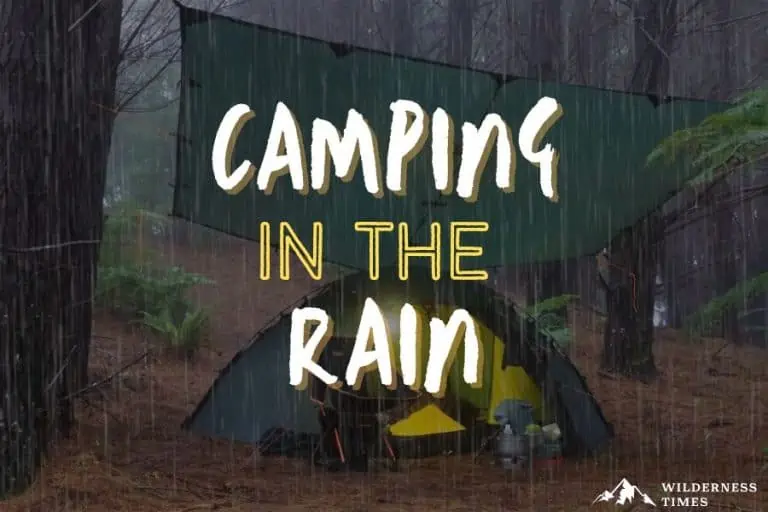Anyone who enjoys a good camping trip either has or will end up camping in the rain at some point.
And if you’re not prepared for it, it can end up messing up your entire experience.
Weather can change in the blink of an eye and even the sunniest of days can turn into rainy ones.
So, gear up and get ready. This is how you go camping in the rain:
Table of Contents
ToggleHow to Prepare to go Camping in the Rain
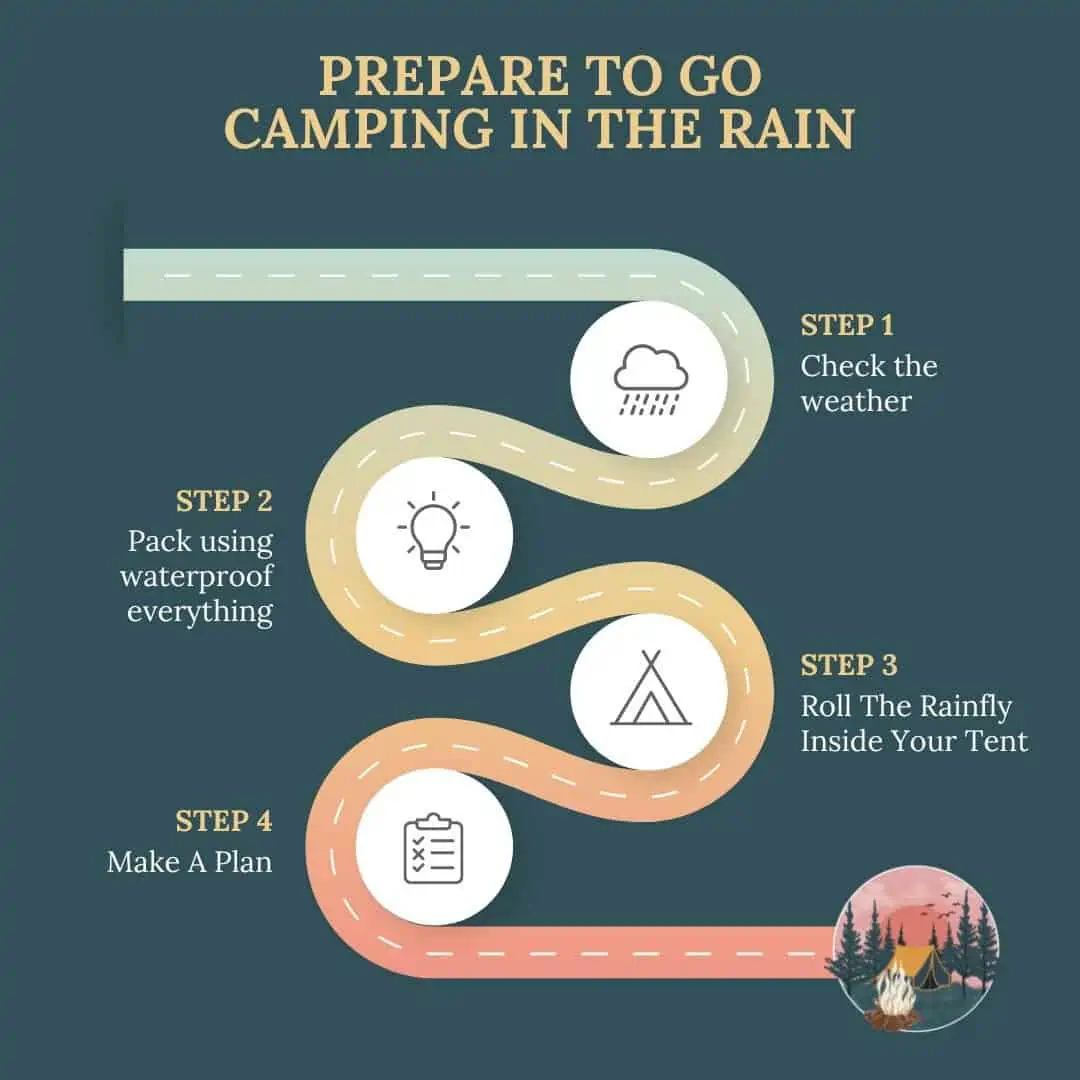
The best camping hack for rain is to prepare as much as possible before you go! The more prepared that you are, the better off you will be.
Check the Weather
First things first: always check the weather before you go camping, especially if you suspect it may rain.
Make sure you are checking the location you will be camping in and the location of your home.
Camping in rain can be more fun than you think! But if you find that severe weather is something you have to contend with, consider altering your plans for your own safety.
As always, use your best judgment.
Pack Using Waterproof Everything
Your next step will be to start packing! Start by packing all your camping gear in waterproof backpacks, dry bags, dry sacks, and storage bins.
This is an added layer of protection to help keep everything dry.
Hopefully, that’s all it is: a precaution. But just in case the worst does happen, you’ll have peace of mind knowing that your clothes, food, and other belongings are nice and dry.
Related: Camping Storage Ideas (18 Tips to Get Organized In No Time)
Double-check Your Tent’s Waterproof Coating
Nothing can be worse than showing up to the campsite only to realize that water isn’t beading up on your rainfly properly.
So it’s best to get your rainfly out and test it. I suggest bringing it outside and spraying a bit of water on it with a hose to see if it’s still repelling water properly.
If you find that your DWR (durable water repellent) coating is no longer working, you will want to get a tent waterproofing spray.
Roll the Rainfly Inside Your Tent
When packing your tent, it’s a good idea to roll the rainfly inside of the tent with the exterior facing outwards before you ever leave your home.
This way, when you are setting up camp and pulling your rainfly out, the rainfly exterior is what takes the brunt of the rain, not the interior.
If the interior were to get wet, it would drip water onto the mesh of your tent, potentially getting the inside wet.
Make a Plan
One of the best things you could do is make a plan for how you will set up camp once you get there and practice it, especially if it will be raining when you get there.
This ensures you will know exactly what you’re doing so you don’t have to figure it out in the pouring rain.
Plus, the faster you get camp set up, the less chance you have of something getting wet.
And, it never hurts to make sure everything is working like it’s supposed to before you leave!
Choose the Right Campsite for Rain
Choosing the right campsite can be just as integral for camping in the rain as all your preparations. After all, it sets up your entire camping experience!
High and Dry
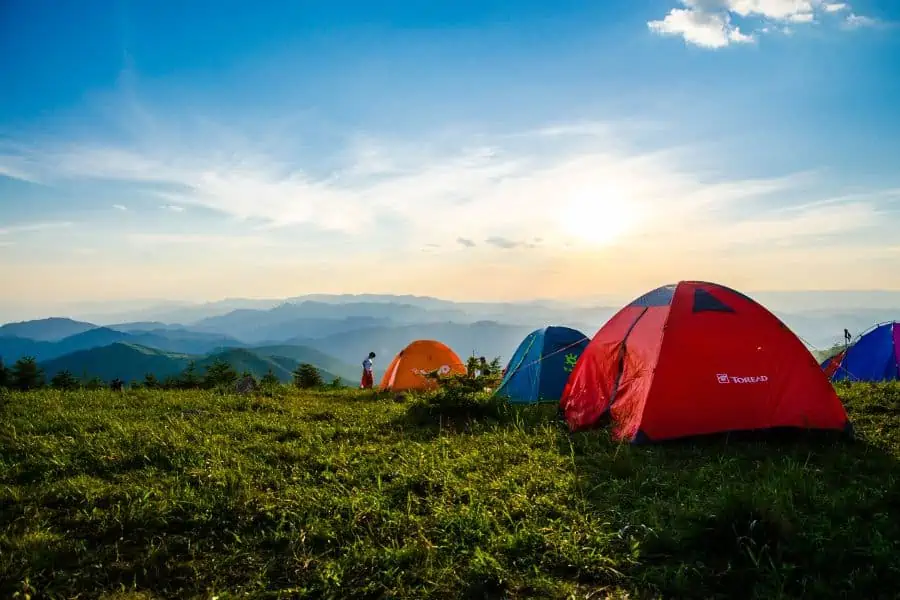
If you have the luxury of being able to choose a specific camping site in the rain, make sure that you can pitch your tent on higher ground.
You’ll want to avoid camping on lower ground, the bottom of hills, and anywhere where rainwater will run and stand.
This also includes places next to creeks, streams, and rivers where water may also rise quickly.
Avoid Trees and Puddling Water
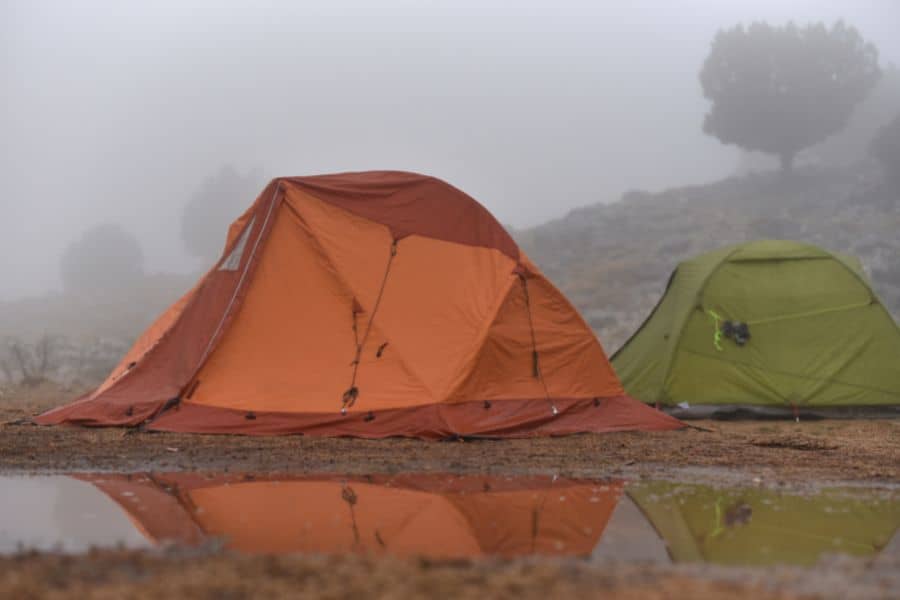
You’ll also want to avoid camping under trees. They may seem like a good idea at first.
But even after the rain stops, their branches will still be dripping water on your tent and your head for hours to come.
Setting up a Tent in the Rain
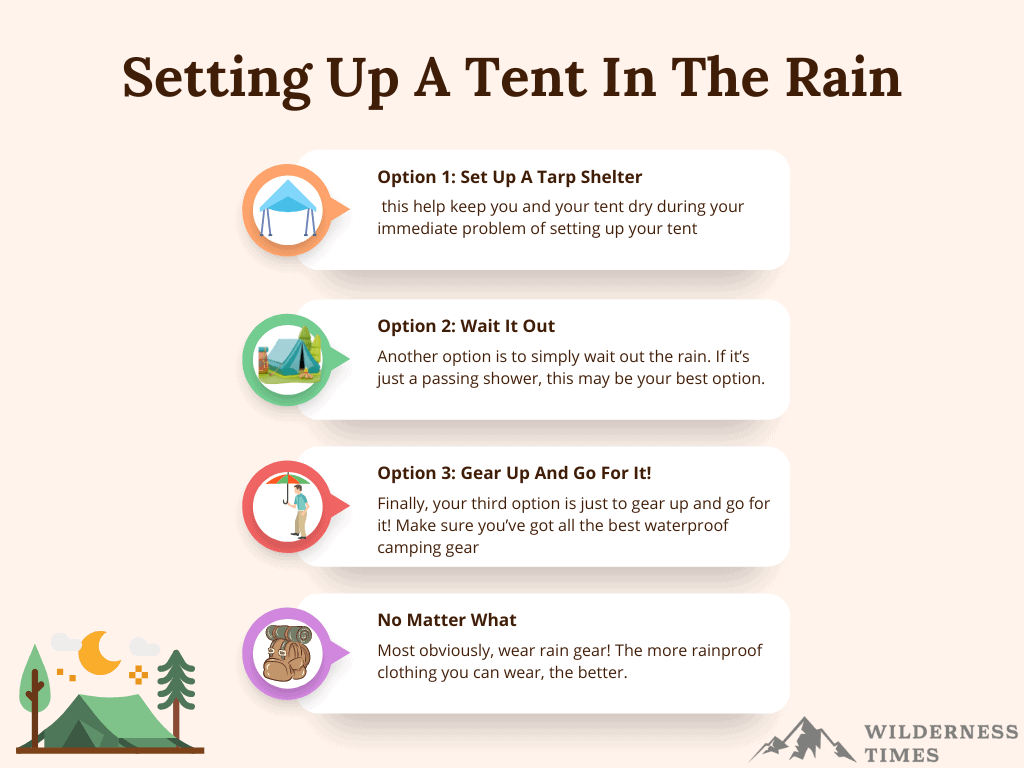
When it comes to setting up a tent in the rain, there are a couple of different ways you can go about it.
Option 1: Set Up a Tarp Shelter
First, you could set up a tarp shelter above your campsite.
Not only does this help keep you and your tent dry during your immediate problem of setting up your tent, but if you leave it up, it can also provide backup in case your tent’s waterproofing fails or even give you a covered area to enter and exit your tent.
Option 2: Wait it Out
Another option is to simply wait out the rain. If it’s just a passing shower, this may be your best option.
However, if it’s going to be raining during your entire camping trip, you may not have this luxury.
A camping hack for rain is if you’re waiting it out and you’ve got your car nearby, park your car over the spot you want to set up your tent before the rain begins.
When the rain is over, you’ll have a nice, dry spot to pitch your tent!
Option 3: Gear Up and Go For it!
Finally, your third option is just to gear up and go for it! Make sure you’ve got all the best waterproof camping gear and clothes and just get busy setting up your site.
You will probably get wet in the process but if you do it right, you will save yourself a lot of trouble in the future.
No Matter What
No matter which option you choose, there are a few things you can do to make setting up a tent in the rain much easier:
- Most obviously, wear rain gear! The more rainproof clothing you can wear, the better. Trust us when we say spirits can get dampened if you get soaked to the bone in the first few minutes of your camping trip.
- Another good thing you can do is to roll your rainfly inside of your tent with the exterior facing out before you ever leave home. This will save you a lot of time when you are setting up your tent, as well as keep rain from dripping down from your rainfly onto the top of your tent once it’s good to go.
- To make setup quicker and easier, pack your tent parts separately and in easy-to-reach spots. Instead of everything being lumped together in one location where you have to hunt for each individual piece, you can just grab what you need, set it up, and move on.
- While setting up, as well as while camping, in the rain, keep your tent doors zipped. Do this before you pack up and leave home to keep rain from blowing inside your tent before it’s even set up.
- Finally, make sure you bring plenty of towels! You can use them to towel off things that get wet, including the inside of your tent before you start bringing everything in, as well as yourself!
How to stay dry while camping in the rain
When camping in the rain, you’ll want to stay as dry as possible. Thankfully there are several measures you can take to make sure this goes off without a hitch.
Lay Down a Groundsheet
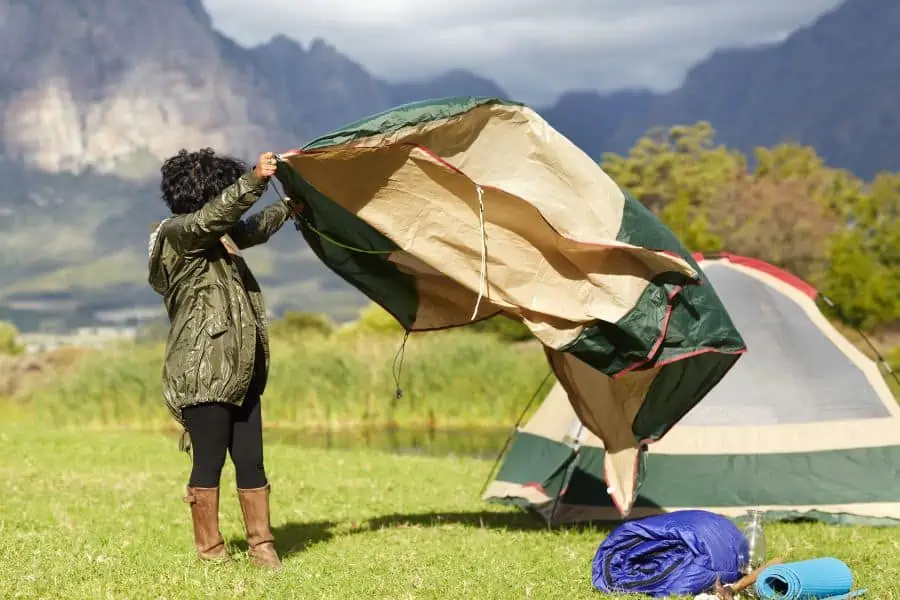
Before you pitch your tent, throwing down a groundsheet or heavy-duty tarp underneath it can add extra protection to your camping setup.
After all, it never hurt to have an added layer of waterproof material between you and the wet ground.
However, just be sure that the groundsheet or tarp is not bigger than the bottom of the tent so that it sticks out.
If it does, water could travel between the tarp and your tent and puddle underneath.
Get a Tent with a Good Rainfly
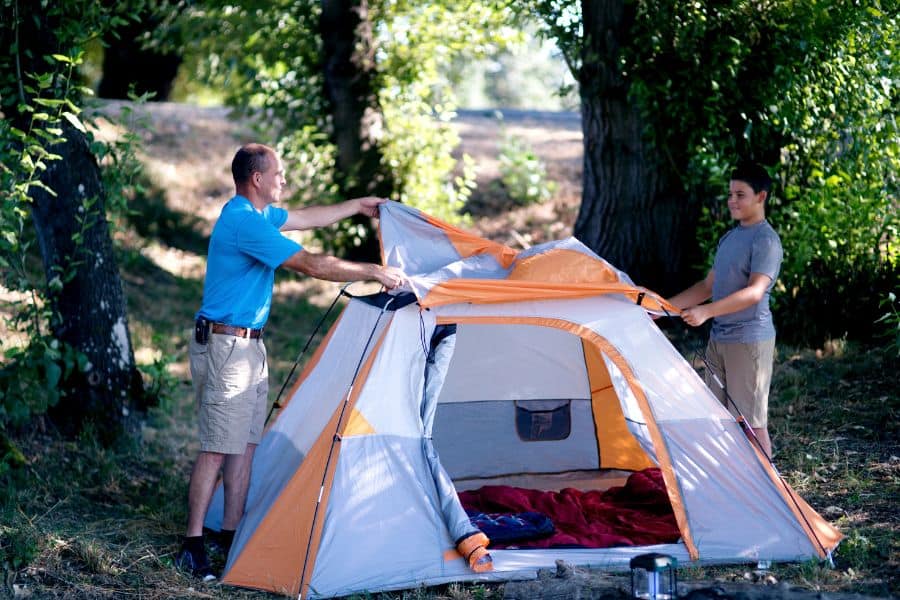
Since the rainfly is the main component of your tent that will be keeping you nice and dry, make sure that you’ve got a good one.
After all, some tents have rainflys that only cover the top of the tent while other rainflys cover all the mesh vents and windows.
And, of course, it’s always a good idea to make sure you know how to set it up and that everything is working properly before you head out on your camping trip.
Related: 10 Best Family Tents For Bad Weather In 2022
Take Off Your Shoes
Any time you have to enter your tent, make sure you are taking your shoes or boots off.
This ensures you won’t be tracking water, mud, or anything else you don’t want to be cleaning up all over your tent.
Keep Tent Doors Zipped
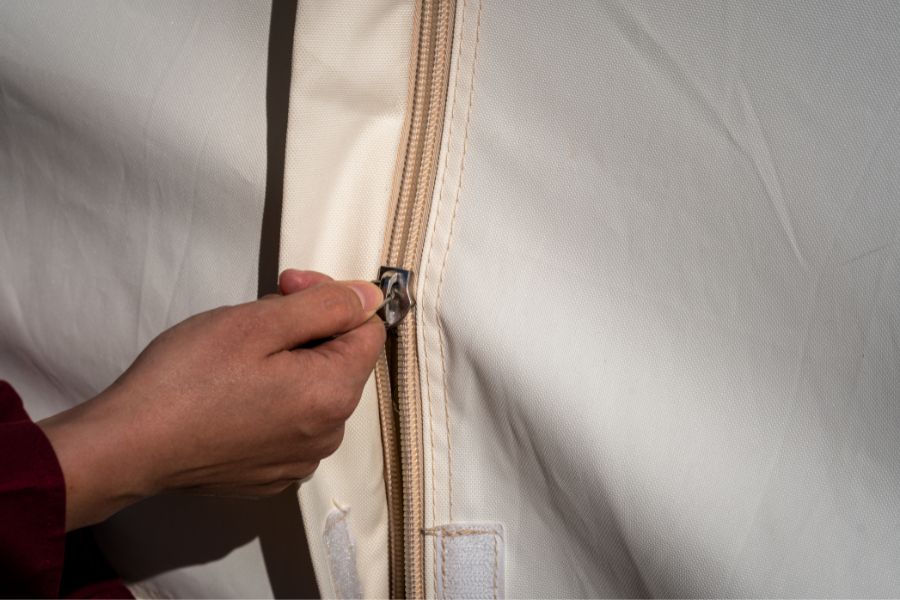
It may be tempting to want to unzip your tent doors now and again to air things out and clear out condensation, especially if it’s muggy, but this could just allow rain to be blown in by the wind and soak your tent’s interior.
Condensation and mugginess are much less of a hassle than a soaking wet tent interior. You can always air things out when the rain stops.
Bring an Extra Tent or Tarp for Gear Storage
If it’s going to be raining for an extended period of time, bringing an extra tent or tarp to store your camping gear can be a great way to keep things dry.
Not only will you be storing your gear somewhere dry, but it will also keep you from going in and out of your own tent, accidentally letting rainwater in, all day or night long.
Store Your Gear in Waterproof Bags and Bins
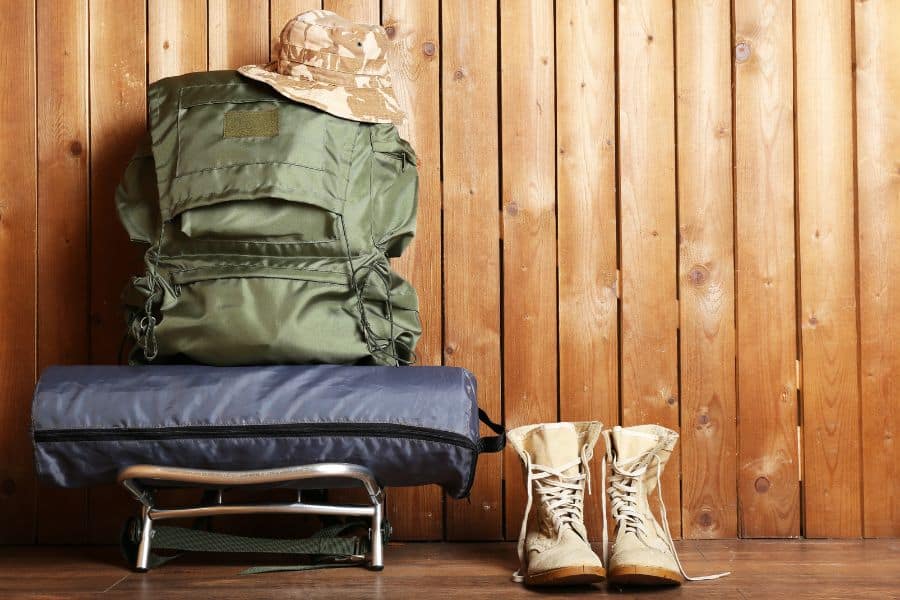
Packing your camping gear in waterproof bags, dry bags, and even plastic storage bins can ensure that everything stays dry for your entire trip.
Not only will things stay dry while you are transporting them around your campsite, but you will also have the peace of mind knowing everything is safe if the worst does happen!
Bring Extra Towels
The more towels, the better! Pack more than you think you’ll need so you can always have one handy to wipe off anything that gets wet, yourself included!
Clothes and Gear for Rain Camping
Your clothes and gear are the most important aspect of learning how to camp in the rain, especially if you want to enjoy it! Staying dry and warm is of the utmost importance.
Waterproof Hiking Boots

If you’re camping in the rain, your feet are going to be in water.
So waterproof hiking boots are one of the items of clothing you absolutely need.
Keeping your feet dry should be a priority. Trust us when we say you’ll notice as soon as your feet get wet, and it won’t be pleasant.
Waterproof Jacket and Pants
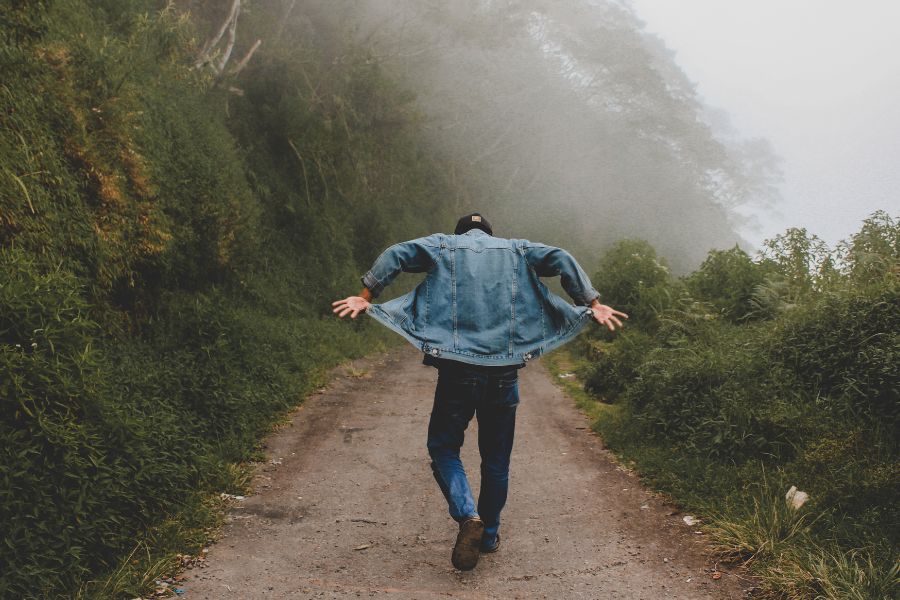
Most people have a waterproof jacket high up on their list of gear when camping in the rain, but not many consider waterproof pants.
But they can be just as essential as the jacket!
They help keep you just as dry below the waist as a jacket does above the waist! And a good one will also have ventilation so you won’t be sweating to death on the inside.
Leg Gaiters
Leg gaiters can be essential if you’re hiking, even if you are wearing waterproof pants.
They can help ensure that when walking through wet underbrush, water does roll down and collect in your socks and shoes.
After all, what’s worse than wet shoes that take forever to dry out?
Extra Large Poncho and Backpack Covers
Items like extra large ponchos and backpack covers can help give your belongings added protection, especially if you are carrying items with you on a hike.
Backpack covers simply go over your backpack while large ponchos are large enough to cover yourself and your pack.
Proper Layers
Getting your layering system right is the trickiest part of dressing for camping in the rain.
The main thing you want to remember is that your outermost layers should be waterproof while your inner and mid layers should consist of fabrics like polyester or wool if it’s cold out.
Try to stay away from cotton. When cotton gets wet, it stays wet. And that’s not what we want when camping in wet conditions.
Extra Change of Clothes (Especially Socks)
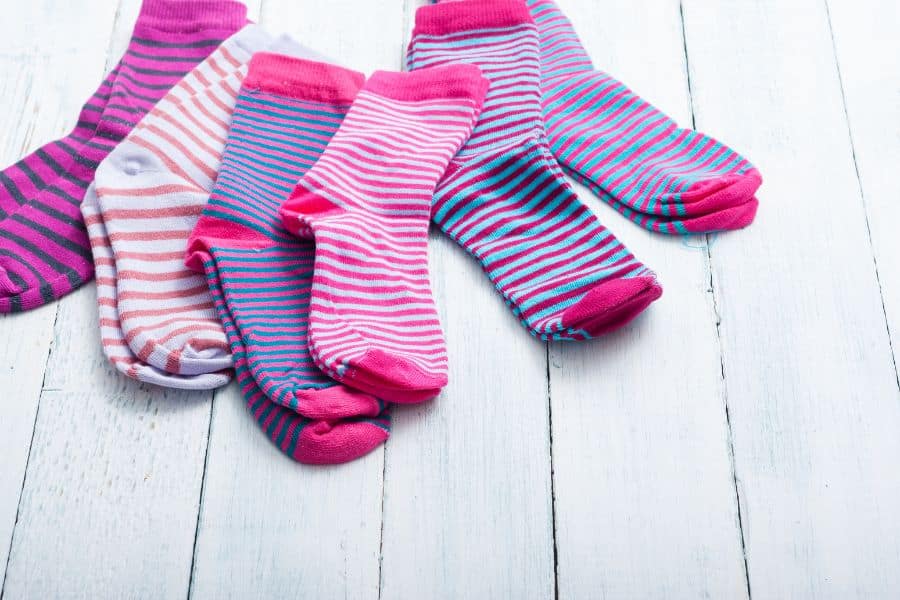
Do yourself a favor and pack an extra change of clothes (or two or three) for “just in case.” And don’t forget the extra socks!
There’s nothing like having your feet stuck in cold, wet socks after a long hike and being able to come back to camp and put on a nice dry, warm pair.
Staying Warm When Camping in Rain
If you’re camping in the rain in cooler months, you run the risk of staying cold, especially if you get wet.
But there are a few things you can do to warm up when things get chilly!
Bring Hand Warmers
Putting hand warmers in your pockets, boots, and even in your sleeping bag can go a long way.
You may find they last longer than you think!
Blankets
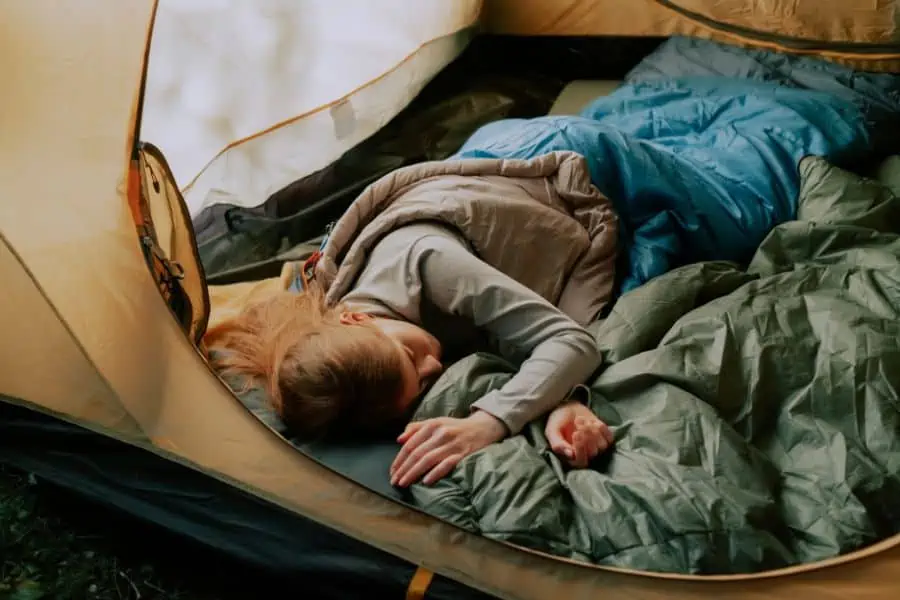
Blankets are a no-brainer when you get cold. But when camping? Opt for a camping blanket.
Camping blankets go above and beyond normal blankets. They’re more durable, they’re waterproof and insulate your body heat.
Layer up with these and a zero degree sleeping bag, and you’ll be warm in no time!
Read: Camping Blanket vs Sleeping Bag: Which is Better for Camping?
Tent Heater
If it’s going to be really cold, consider a tent heater to keep you warm and toasty any time you’re tucked away inside your tent.
There are a wide variety of tent heaters on the market, from electric to non-electric.
Of course, choose the one that suits your camping conditions the best.
Create Dry Outdoor Spaces with Tarp Shelters
Just like hanging a tarp over your campsite to help you set up your tent without it getting soaking wet, you can set up tarp shelters all over your campsite for a variety of purposes.
Hang-Out Space
Setting up a tarp shelter over the entrance to your tent or in a central location can give you a dry area to hang out in that isn’t inside your tent.
Not only does this give you more than one location to hang out in while camping, but it also helps you avoid tracking messes into your tent when it’s not necessary.
Camp Kitchen
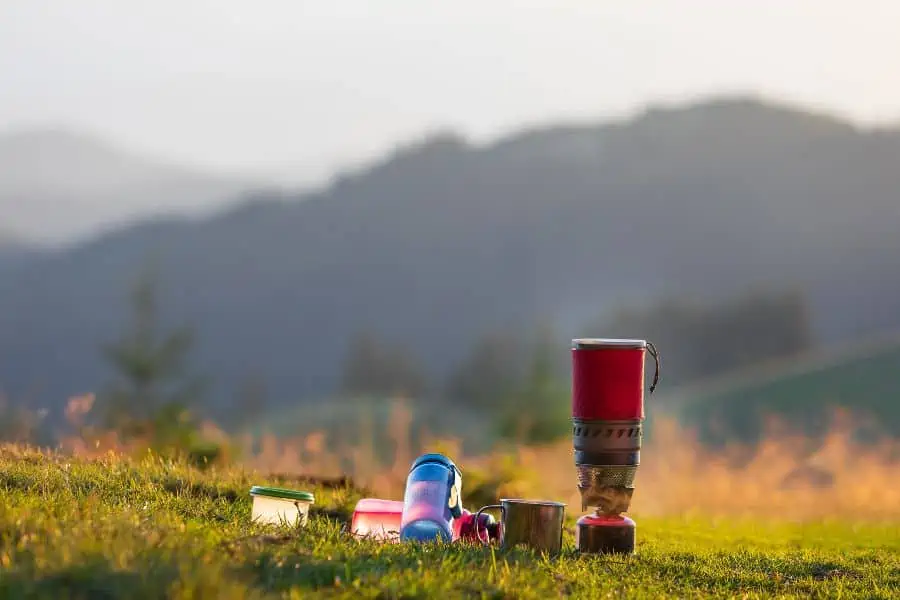
You can also use a tarp to cover your camp kitchen for easy meal times! No one likes soggy meals, so it’s always good to be out of the rain while cooking meals.
And just throwing a tarp overhead means you don’t have to worry about a build-up of toxic fumes like carbon monoxide from gas stoves.
And, of course, never, ever cook or prepare meals in your tent. You don’t want to attract any unwanted critters!
Starting a Campfire in the Rain
Starting a campfire in the rain may sound daunting, but it doesn’t have to be!
In fact, learning how to properly start a fire in the rain may be one of the best camping hacks for rain you could learn.
1. Shield Your Fire From Wind
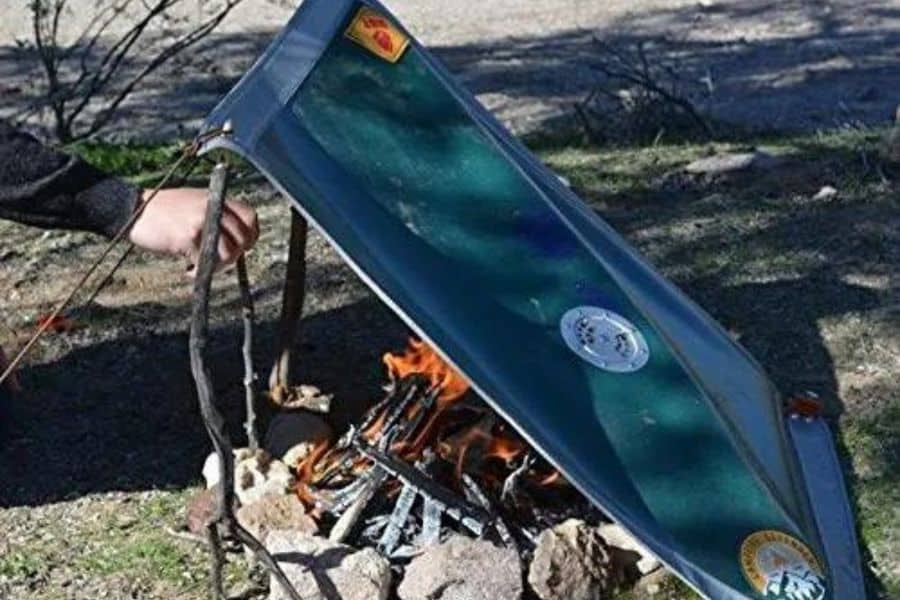
Before you start your campfire, you need to find the best location for it. The best location for your campfire is one that shields it from the wind.
Somewhere such as beside large objects like rock formations or hills works best. Just make sure you are downwind so the object blocks the wind!
If you can’t find a natural way to block the wind, you can create one with a tarp and sticks or trees.
2. Shelter Your Fire From Rain
This step can be tricky as you always need to ensure that the smoke that your fire produces can escape.
Evergreen trees like spruces and pines tend to be a great natural shelter because their branches form something like a natural roof.
The smoke from your fire can escape while the water droplets fall outward.
Try to build your fire underneath some of the tree’s lower branches for optimal results.
However, be very careful and make sure that you control your fire so as not to turn it into a disaster.
3. Use Dry Kindling and Wood
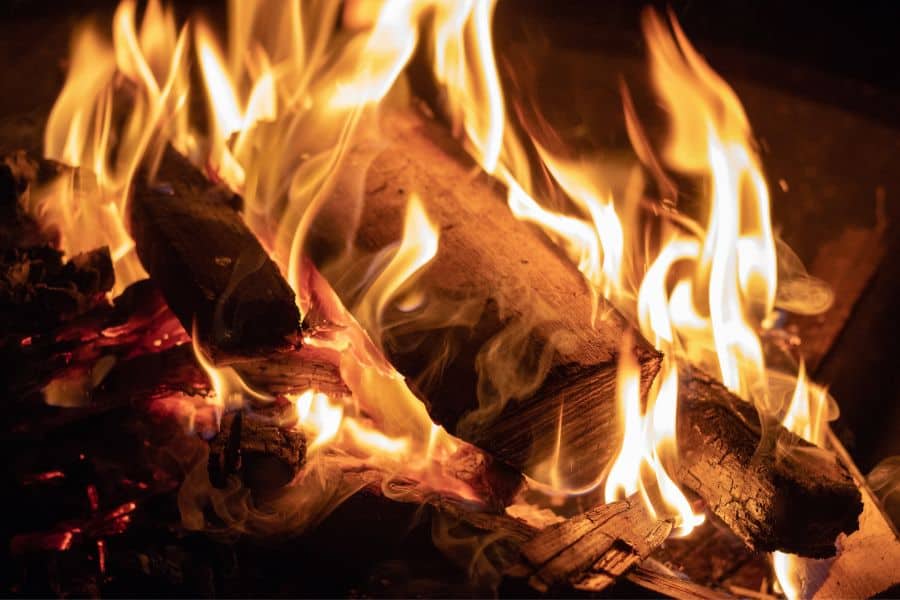
This may be the most obvious step but you will not be able to start a fire with wet fire or kindling.
If you arrive at your campsite before the rain, go ahead and start collecting your kindling and firewood while it’s still dry.
If that’s not an option and all of the wood in the area is already soaking wet, you’ll need to either bring your own or purchase some when you get there.
To keep it dry while you’re camping, a tarp will be your best friend.
Rig up a tarp shelter specifically to keep your firewood and kindling dry so you don’t have to worry about it anymore because, in the rain, that fire will be your best friend.
4. Start Your Fire
Go ahead and light it up! You should have a firestarter as one of your essential camping items on hand.
Whether you prefer matches, a flint, or a lighter, now’s the time to use it.
However, we do recommend a lighter if you’re camping in the rain as it provides less of a chance for the rain to put it out. Plus, they’re super quick and easy!
Cooking in the Rain
If you want to learn how to camp in the rain, you need to learn how to cook in the rain. But don’t worry- it’s easier than it sounds!
1. Setup a Tarp Shelter for Your Camp Kitchen
You don’t want to cook in your tent or your tent’s vestibule, so a tarp shelter is the next best thing.
Setting up a tarp shelter over your camp kitchen can make it easier (and drier) when it comes to meal times.
Plus, it gives your campsite a nice space for everyone to congregate at meal times if your camping with a group!
2. Portion Out Meals Ahead of Time
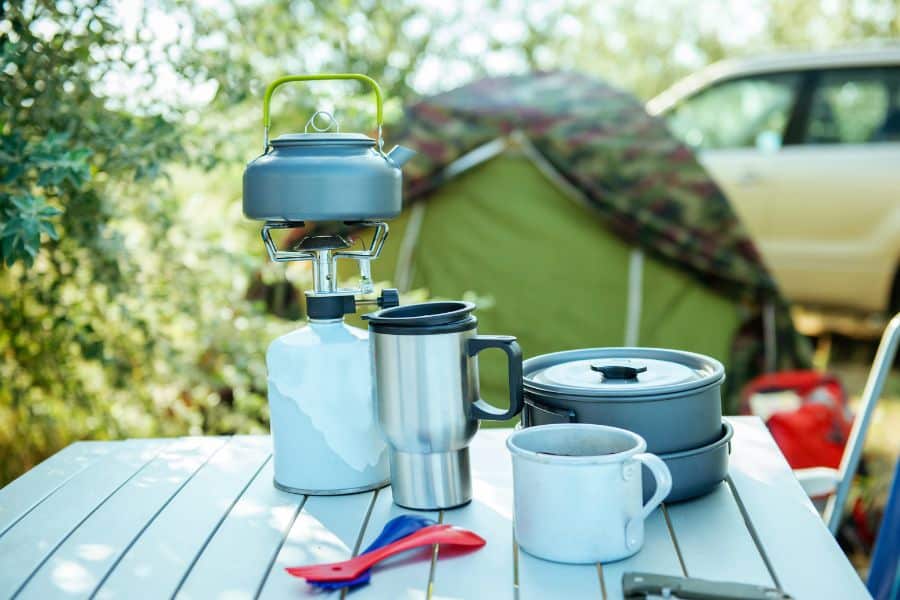
Before you leave home, go ahead and get your meals ready if you can. You’ll already know what you’re going to be cooking anyway.
So why not prep what you can?
Portioning out everything ahead of time can not only save you time but can save you a lot of hassle if you’re working against rainy conditions.
Put everything you need for one meal in a ziplock back or Tupperware container and label it.
That way, when it’s time to cook that meal, you can just grab it and get to cooking!
3. Prepare Some Meals Ahead of Time
In some instances, you could prepare your camping meals ahead of time.
If you know it’s going to be raining during your camping trip, consider specifically planning to cook meals that you can prepare ahead of time to make things easier.
Things like sandwiches, casseroles, and soups can all be thrown together ahead of time, only to be heated up or cooked at meal time.
No worrying about chopping, stirring or mixing.
4. Organize Your Cooking Area
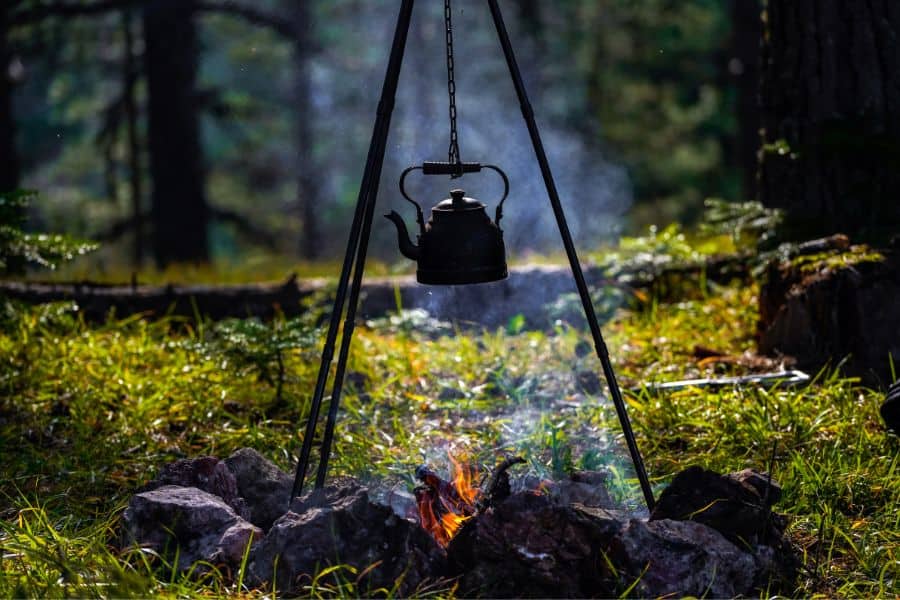
When you’re organized, it’s much easier to find the things you need when you need them. The same principle applies to camping in the rain.
If you organize your cooking area before mealtime, you’ll know where everything is when it comes time to cook.
That means spending less time in the elements and potentially getting wet.
5. Get Cooking!
If you do all you’re prep work out of the rain ahead of time, there won’t be much more for you to do except get to work cooking!
And isn’t that the best part? Other than eating, of course!
As long as you are bundled in all your weatherproof gear with a clear game plan in mind, that meal will be one of the best you’ve ever eaten!
What to do when camping in the rain?
Camping in the rain doesn’t have to be less fun than regular camping.
If you think that there’s nothing to do when you’re camping and it starts to rain, think again!
In fact, having a solid list of activities prepared is one of the best camping hacks for rain.
So what should you do when camping in the rain? Try:
- Hike in the Rain
- Playing Cards
- Read a Book
- Tell Jokes
- Build a campfire under cover
- Tell Stories
- DIY Crafts
- Coloring Books
- Play a Game or Watch a Movie
- Board Games
For more ideas, check out this full list of 65+ camping activities.
FAQs:
Is it worth camping in the rain?
Camping in the rain can be a fantastic experience! As long as you are prepared for it.
If you are not prepared, camping in the rain can really put a damper on your whole trip.
Should you put a tarp over your tent?
Putting a tarp over your tent can be beneficial for many reasons. For one, it ensures that no rain is getting in your tent.
But it also helps insulate your tent and even extends your livable space.
How do you keep a tent dry in the rain?
Hopefully, you have a waterproof tent or one that comes with a waterproof rainfly.
This will help keep your tent dry. But if you have neither of those things, rigging up a tarp with ropes over your tent will achieve the same effect.
What do you need to dry your clothes?
Pack extra rope to use as a clothesline and string it up somewhere dry in your camp, whether under a tarp shelter or inside the vestibule of your tent.
Hang wet clothes here and allow them to dry.
What type of camping equipment do you need for the rain?
When camping in the rain, you’ll need waterproof everything.
Things like a tent with a waterproof rainfly, waterproof clothing, plenty of waterproof containers and tarps, a lighter, and dry firewood make up the essentials.
How do I create a good campfire in the rain?
Creating a good campfire in the rain requires being able to block out the wind, sheltering the fire from the rain, and dry firewood and kindling.
With just a little planning, you can have a nice, roaring campfire!
What extra gear do I need to go camping in the rain?
Besides your essential waterproof items, you should consider packing extra layers of clothing, a clothesline for drying clothes out, a gas stove for cooking, and a tent heater if it’s going to be really cold during your trip.
Final Thoughts on Camping in the Rain
As you can see, there’s a lot of work and planning that goes into camping in the rain. But it can really be worth it!
Rain doesn’t have to put a damper on the entire trip if you’re ready for it.
So, check the forecast, be prepared, and, most importantly, have fun!
Next up: How Much Wind Can A Tent Withstand?
More on Camping in Bad Weather


